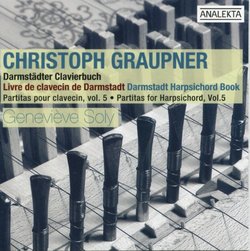| All Artists: Geneviève Soly Title: Graupner: Partitas for Harpsichord, Vol. 5 Members Wishing: 1 Total Copies: 0 Label: Analekta Original Release Date: 1/1/2006 Re-Release Date: 4/5/2007 Album Type: Import Genre: Classical Styles: Chamber Music, Historical Periods, Baroque (c.1600-1750), Classical (c.1770-1830) Number of Discs: 1 SwapaCD Credits: 1 UPC: 774204911829 |
Search - Geneviève Soly :: Graupner: Partitas for Harpsichord, Vol. 5
 | Geneviève Soly Graupner: Partitas for Harpsichord, Vol. 5 Genre: Classical
|
Larger Image |
CD Details |
CD ReviewsA Near Contemporary of Bach Whose Music is Entirely Differen J Scott Morrison | Middlebury VT, USA | 02/03/2006 (5 out of 5 stars) "Who is Christoph Graupner, you ask? Well, he was born two years before Johann Sebastian Bach and was even a pupil at the celebrated Thomasschule in Leipzig (before Bach took it over), studying under the then-Kapellmeister, Kuhnau. He went to law school but abandoned that for music, moving to Hamburg where he became friends with Telemann. He ultimately wound up in Darmstadt where he was director of the Hofkapelle and where he remained the rest of his life. He is primarily known as a composer of operas as well as choral and orchestral music. His keyboard music has not been widely known - more's the pity! - until the present artist, Geneviève Soly, a Montreal harpsichordist and musicologist, found and began recording it (along with some of his chamber music). This is, I believe, the eighth CD she has recorded either as soloist or as chamber musician. I've reviewed a couple of the earlier harpsichord CDs and one chamber CD and have been consistently delighted with both the music and the performances.
This CD contains three harpsichord partitas (suites): A minor (GWV 150, ca. 1720), E major (a combination work: GWV 106 [1718] & GWV 109 [1722]) and in C major (another combination work with movements from GWV 109 [ca. 1720] and GWV 126 [1722]). The latter two works were incomplete as they stood and Soly put several movements together to make complete suites. (She even candidly admits that she included some movements simply because 'I liked them ... and wanted to record them!'). Soly wrote the excellent booklet notes and they are quite informative, even scholarly. All that, though, is no matter if one simply sits back and listens to the various movements. This is thoroughly delightful music that has a French cast (and movements are called 'courante', 'allemande', 'rigaudon', 'gigue' and the like) and it seems to point forward to the soon-to-be-called galant style. Counterpoint, while it exists, is much less in evidence than in music by Bach. In some ways it reminds me more of Handel's harpsichord music. In fact, there is one variation movement that reminds me a lot of Handel's immensely popular 'Harmonious Blacksmith.' As for Soly's playing, it is not only technically assured, it is lively, stylish and downright charming. Her harpsichord has a particularly sweet sound. She tends to use lots of dotted rhythms even, she explains, where they aren't written as such; she justifies this from a musicological perspective and I'm certainly no one to argue with her since it gives the music a Schwung that is light and airy. Highest recommendation, particularly for those who are not previously familiar with Graupner's music. It will be quite a pleasant discovery for most, I strongly suspect. Scott Morrison" |

 Track Listings (22) - Disc #1
Track Listings (22) - Disc #1